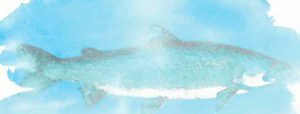Can the Endangered Species Act protect wildlife in a changing climate?
On a summer day in 2011, a group of US Geological Survey researchers hiked through the wildflowers high above Glacier National Park’s tree line, sloshed into the icy stream flowing out of Grinnell Glacier, and began flipping over rocks. They scraped muck from the rocks into nets, hoping to capture the hard-to-see nymphs of an insect that survives only in the cold runoff within 500 meters of year-round snowfields or glaciers.

Scientists first described the extremely rare western glacier stonefly (Zapada glacier) in the 1970s, after they collected the insects in six of the park’s high mountain streams. But glaciers feeding those mountain streams have shrunk by 39 percent on average since 1966, according to USGS data released last year. After surveying the original streams for three summers beginning in 2011, researchers concluded that only one of the original insect populations remained. Meanwhile, two new populations showed up in higher elevation waters. With Glacier National Park’s 25 largest glaciers projected to disappear by 2030, soon the stoneflies won’t be able to climb any higher.
Glacier National Park’s stoneflies aren’t simply obscure victims of climate change. “They’re indicative of an entire ecosystem, and complex food webs that we know little about,” says Clint Muhlfeld, an aquatic ecologist for the USGS Northern Rocky Mountain Science Center, and one of the scientists involved in the stonefly study. And they are one of thousands of species declining globally.
Glacier’s stoneflies are indicative of global declines for climate-sensitive species. According to a 2012 study in the journal Nature Climate Change, melting glaciers in Ecuador, the Alps, and Alaska could lead to the loss of 11 to 38 percent of alpine invertebrate species in those regions. In 2016, a small Australian rodent called the Bramble Cay melomys was the world’s first mammal known to go extinct because of climate change. Sea level rise inundated its island habitat. Local extinctions due to climate change are much more common. In a 2016 PLOS study, 47 percent of 976 plants and animals surveyed worldwide had gone extinct locally.
In 2016, the US Fish and Wildlife Service proposed protecting the western glacier stonefly under the Endangered Species Act. In the United States, the ESA is the last line of defense against extinction for many creatures. But when animals or plants are at risk of extinction because climate change is altering the ecosystem around them, it puts scientists and managers in a tough spot. “It’s a paradox for ecosystem managers,” says Muhlfeld. The USFWS, “is going to list the species, but what can we do to slow or stop the effects of climate change on those species?”
That’s a big question that managers and scientists charged with protecting species are now striving to answer. In the process, they’ve developed a range of innovative strategies to cushion species from climate change. They’ve improved ecological and climate models to forecast where future habitat will meet species’ needs, while using those predictions to strategically restore habitat or even relocate animals. Meanwhile, policy-makers have gradually applied the Endangered Species Act to better account for ever-changing ecosystems. But the stoneflies’ extreme plight is just one example of how difficult it is to keep species around when the most managers can do is address climate change’s symptoms, rather than remove its root cause.
![]()
Bull trout, a steely, pink-spotted relative of the salmon, once dominated the cold waters of Pacific Northwest lakes and streams. These stout-headed fish have special habitat requirements: cold, clean water, and connected migratory corridors. In short, they thrive in the kind of wild, undisrupted habitat that is now rare. That loss of habitat, along with threats from non-native fish species, is why the USFWS listed them as threatened in 1999.
 In the years since the trout’s listing, scientists have paid more attention to how warming waters harm cold-water fish species. No other freshwater salmon, or western US trout, needs cold water to survive more than the bull trout. So as with many species affected by climate change, models are now indispensable when managers have to make decisions about how to help the cold-dependent fish find refuge in the future. It’s something Dan Isaak, a fish biology researcher at the US Forest Service Rocky Mountain Research Station in Boise, started thinking about in the early 2000s. At that time, a slew of studies about shrinking snowpack in the West’s mountains gave fish biologists another reason to worry about trout species’ future.
In the years since the trout’s listing, scientists have paid more attention to how warming waters harm cold-water fish species. No other freshwater salmon, or western US trout, needs cold water to survive more than the bull trout. So as with many species affected by climate change, models are now indispensable when managers have to make decisions about how to help the cold-dependent fish find refuge in the future. It’s something Dan Isaak, a fish biology researcher at the US Forest Service Rocky Mountain Research Station in Boise, started thinking about in the early 2000s. At that time, a slew of studies about shrinking snowpack in the West’s mountains gave fish biologists another reason to worry about trout species’ future.
To get a better idea of what those studies meant in a practical sense, Isaak and his collaborators started mapping where bull trout and cutthroat trout occur today, along with stream temperature data, and projections of future stream temperatures. They named their model the Cold Water Climate Shield because it helps identify where cold water is most likely to protect fish from future warming.
Scientists have been building coarse temperature models to predict trout species’ futures for 25 years, and the results mostly looked grim. But while older models were air temperature-based, Isaak’s model incorporates millions of stream temperature records with bull trout habitat data collected by biologists all over the fish’s range. The more detailed model that represents habitats where bull trout live today, and where they are likely to live in the future, told a more optimistic story.
“It seems to be suggesting that these cold-water trout populations, at least the ones that live up in the headwaters of these river networks, are a lot more resistant to climate change than what we’ve been hearing for the last 20 years,” says Isaak. “So as it warms up it’s certainly not going to help them, but they’re certainly not going to go extinct the way people thought.”
For managers, that means there’s no need to write bull trout off. Instead, they can use the models to give bull trout a boost as the future becomes more stressful for them. That may mean taking a more targeted look at where agencies do restoration work, or planning for more extreme actions like moving fish populations out of harm’s way.
In recent years, managers have been translating modeling and habitat studies into conservation actions to help bull trout adapt to climate change. “Are bull trout going to disappear from the planet in the next 50 years?” says Wade Fredenberg, the Fish and Wildlife Service’s bull trout recovery coordinator for western Montana. “Even under the most extreme scenarios the answer’s no. But they already have disappeared and will disappear from some places. The key for us is to try to figure out where the refugia are, and where to put our efforts into those places so that we can maintain and if possible expand those habitats.”
The US Forest Service is using the Cold Water Climate Shield to figure out where to reclaim roads that damage trout habitat. Those projects are expensive and can be controversial with the public, so it’s important to invest in restoration that will remain relevant as climate changes.
State wildlife managers, along with the Forest Service, are also using the model to assess if they should establish new, higher elevation bull trout in Montana’s Scapegoat Wilderness. Putting animals where they’ve never been found before is an uncommon approach to helping threatened and endangered species weather climate change. But with guidance from sophisticated models, and increasing pressure from climate and invasive species, helping fish reach higher waters is starting to look like a sound conservation strategy.
Managers are already moving fish in Glacier National Park, where in 2014, the National Park Service started a project to rescue bull trout populations from both invasive species and climate change. Muhlfeld and his colleagues at the USGS used climate and habitat data, and models, to identify a high-elevation lake that will continue providing cold habitat for bull trout spawning. It’s also important that the lake sits above a cliff that keeps invasive trout out. Managers have captured over 100 bull trout, placed them in special backpacks full of oxygenated water, and hiked them several miles up the mountain to release them in a lake where bull trout haven’t lived before.
Trout translocations, as they are called, are an example of how climate change has forced managers and researchers to be more forward-looking when it comes to endangered species. “You’ve got to go out on the limb in the face of uncertainty sometimes,” says Muhlfeld. “I think climate [change] kind of changed the way we’re looking at systems and species. We’re transitioning from a reactionary mode to a proactive mode in terms of trying to identify opportunities for climate adaptation.”
![]()
As managers on the ground have made headway with proactive conservation that accounts for climate change, federal policy makers have also applied a forward-looking perspective to the Endangered Species Act. Similar to bull trout, the USFWS expects climate change will cause lower elevation and lower latitude populations of southern California’s Quino checkerspot butterfly to disappear. The tiny orange and white-flecked butterfly was once one of Southern California’s most common, but development ate away at its grassland, shrub, and chaparral habitat. It landed on the endangered species list in 1997. Now that its populations are small, they are at risk of extinction from drought, above average temperatures, and extreme weather events.
To protect the Quino checkerspot butterfly from climate change, federal wildlife agencies have adapted the critical habitat provision of the ESA to consider how habitat will change along with the climate. The main point of critical habitat is to identify areas essential for a species’ survival and ensure that the federal government’s activities don’t harm protected plants or animals. In the butterfly’s case, the USFWS used critical habitat designation to set aside a migration corridor where the butterfly doesn’t live today, in case the at-risk core population needs to move to a higher elevation part of its range.
By focusing on unoccupied critical habitat designations, the USFWS acknowledged that the ESA is now trying to hit an ever-moving target. “Designating critical habitat outside the [butterfly’s] historic range is a pioneering response to climate change,” researchers wrote in a 2014 paper about the Quino checkerspot butterfly. “This politically challenging, non-traditional, climate change-oriented conservation effort exemplifies flexible thinking needed for species vulnerable to climate change.”
In the future, it’s likely that more critical habitat designations will include places where species do not live today, but which will become important as the climate changes. That could mean securing higher, colder mountain habitat, future beach front, or wetlands as sea level rises, or migratory corridors that species may need to move from place to place. In February 2016, the USFWS amended its critical habitat regulations that make it easier to designate habitat unoccupied by a species at the time of listing. Eighteen states are challenging the rules, saying they unlawfully expand federal control over state lands and waters. The lawsuit is indicative of the political challenge of accounting for climate change while applying the ESA.
Recovery plans are another area of the ESA where the USFWS and National Marine Fisheries Service are gradually integrating flexible thinking about climate change. The law’s ultimate goal is ensuring a species’ long-term survival, and recovery plans provide the roadmap for how managers can get there. The USFWS finalized its bull trout recovery plan in 2015. While climate change was not a factor in the fish’s 1999 listing, the recovery plan acknowledges the problem multiple times. The plan states that important bull trout habitat may shift or disappear over time due to climate change, so managers should use the best available research to focus on areas most likely to have cold-water fish habitat in the future. This idea is consistent with how managers are already using models to manage bull trout.
In addition to the plan for bull trout, hundreds of other recovery plans mention climate change, according to Shaye Wolf, the Center for Biological Diversity’s climate science director. Some call for actions to help species adapt, or note that they require a cooler habitat to recover. For instance, the recovery plan for West Coast salmon calls for restoring streamside vegetation to shade rivers and reduce temperature stress on the fish. Others point out that greenhouse gas reductions are ultimately needed to save a species.
When recovery plans acknowledge the cause of climate change, they brush up against an ultimate question about the ESA’s role in a shifting climate: Can the act address the root of the problem? Can it, and should it, regulate greenhouse gas emissions?
![]()
With some species already in peril from climate change, it appears that the ESA alone won’t be enough to hold the line against extinction. Even if the federal government wanted to claim that greenhouse gas emissions that modify a species’ habitat are a “taking”—meaning something that kills, bothers, or otherwise harms endangered animals—it’s not clear how such a policy would work in practice, argues Vanderbilt University Law School professor and ESA expert J. B. Ruhl.
“Are you going to regulate the entire greenhouse-gas-emitting economy?” Ruhl asks. Since every molecule of carbon dioxide is equally responsible for climate change, it’s impossible to pinpoint who is liable for harming bull trout, or western glacier stoneflies, he argues. “That’s why the agency through both Republican and Democratic administrations has said, ‘We’re not going there.’”
For example, the USFWS clearly spells out this position in its bull trout recovery plan when it states that “addressing the root causes of greenhouse gas emissions and climate change is not within our jurisdiction.” The plan does go on to note that managers should “proactively protect those habitats that are expected to best maintain cold water conditions suitable for bull trout.”
Some environmental groups do see ways the ESA could support reducing greenhouse gas emissions. When federal agencies plan projects like dams or roads, the ESA requires them to consult with the USFWS or the National Marine Fisheries Service to make sure a project won’t harm listed species. The Center for Biological Diversity, and other groups, argue that this consultation process should also be done for federal projects that emit significant greenhouse gases.
In theory, the ESA’s provisions preventing “taking” could also be used to regulate greenhouse gas emissions. The law against taking also bans “any significant habitat modification that leads to the death or injury of the species.”
“I think that the ESA has played a very positive role when species are protected due to climate change threats, but the ESA can be used more fully to protect climate-imperiled species,” says Wolf. “There’s more work to be done in fully using the law and the benefits that it provides.”
While astute management can still help species like bull trout persevere despite rising temperatures, there is little that can be done for others besides reducing greenhouse gas emissions. For instance, managers are already wracking their brains about how to help the western glacier stonefly, now proposed for addition to the endangered species list. Perhaps it will need to be raised in captivity, or moved somewhere colder. But since it is already as high as it can go in its ecosystem, and already in a protected area, it’s not clear where that would be.
In 2016, scientists found a couple new populations of western glacier stoneflies further south in Montana and Wyoming. But Muhlfeld still thinks they are at high risk because they remain rare and will continue to be squeezed out of a narrow band of habitat. The year-round snow the insects need is no more secure south of Glacier National Park. Even with the potential for ESA protections there seems to be little hope for helping the rare stoneflies adapt.
“[They] could be the first species that we’re aware of here in the US that could potentially go extinct due to climate change,” says Muhlfeld.
By Sarah Jane Keller
Sarah Jane Keller is a freelance science and environmental journalist based in Bozeman, Montana. Find more of her work at sjanekeller.com.


